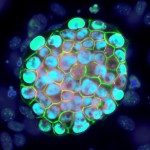Lien vers Pubmed [PMID] – 8747922
Mamm. Genome 1995 Dec;6(12):844-9
Tay-Sachs disease is an autosomal recessive lysosomal storage disease caused by beta-hexosaminidase A deficiency and leads to death in early childhood. The disease results from mutations in the HEXA gene, which codes for the alpha chain of beta-hexosaminidase. The castastrophic neurodegenerative progression of the disease is thought to be a consequence of massive neuronal accumulation of GM2 ganglioside and related glycolipids in the brain and nervous system of the patients. Fuller understanding of the pathogenesis and the development of therapeutic procedures have both suffered from the lack of an animal model. We have used gene targeting in embryonic stem (ES) cells to disrupt the mouse Hexa gene. Mice homozygous for the disrupted allele mimic several biochemical and histological features of human Tay-Sachs disease. Hexa-/- mice displayed a total deficiency of beta-hexosaminidase A activity, and membranous cytoplasmic inclusions typical of GM2 gangliosidoses were found in the cytoplasm of their neurons. However, while the number of storage neurons increased with age, it remained low compared with that found in human, and no apparent motor or behavioral disorders could be observed. This suggests that the presence of beta-hexosaminidase A is not an absolute requirement of ganglioside degradation in mice. These mice should help us to understand several aspects of the disease as well as the physiological functions of hexosaminidase in mice. They should also provide a valuable animal model in which to test new forms of therapy, and in particular gene delivery into the central nervous system.

